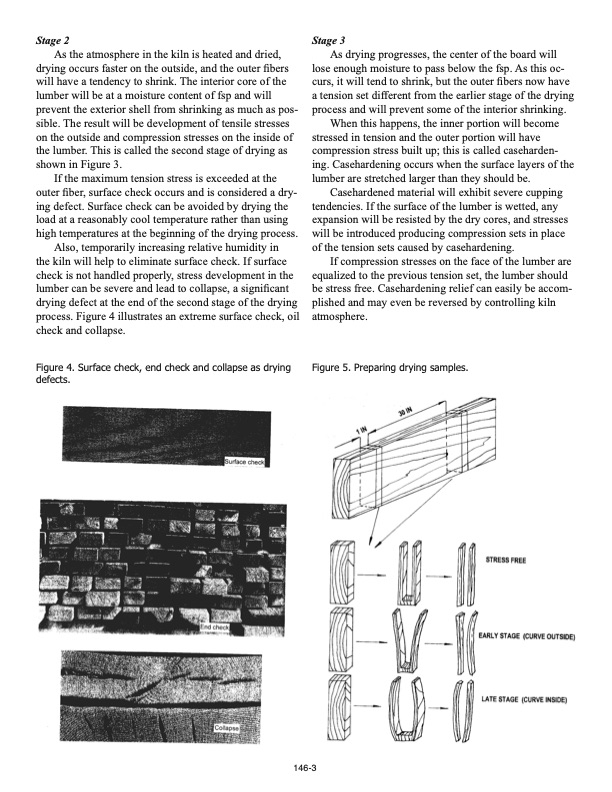
PDF Publication Title:
Text from PDF Page: 003
Stage 2 As the atmosphere in the kiln is heated and dried, drying occurs faster on the outside, and the outer fibers will have a tendency to shrink. The interior core of the lumber will be at a moisture content of fsp and will prevent the exterior shell from shrinking as much as pos- sible. The result will be development of tensile stresses on the outside and compression stresses on the inside of the lumber. This is called the second stage of drying as shown in Figure 3. If the maximum tension stress is exceeded at the outer fiber, surface check occurs and is considered a dry- ing defect. Surface check can be avoided by drying the load at a reasonably cool temperature rather than using high temperatures at the beginning of the drying process. Also, temporarily increasing relative humidity in the kiln will help to eliminate surface check. If surface check is not handled properly, stress development in the lumber can be severe and lead to collapse, a significant drying defect at the end of the second stage of the drying process. Figure 4 illustrates an extreme surface check, oil check and collapse. Figure 4. Surface check, end check and collapse as drying defects. Stage 3 As drying progresses, the center of the board will lose enough moisture to pass below the fsp. As this oc- curs, it will tend to shrink, but the outer fibers now have a tension set different from the earlier stage of the drying process and will prevent some of the interior shrinking. When this happens, the inner portion will become stressed in tension and the outer portion will have compression stress built up; this is called caseharden- ing. Casehardening occurs when the surface layers of the lumber are stretched larger than they should be. Casehardened material will exhibit severe cupping tendencies. If the surface of the lumber is wetted, any expansion will be resisted by the dry cores, and stresses will be introduced producing compression sets in place of the tension sets caused by casehardening. If compression stresses on the face of the lumber are equalized to the previous tension set, the lumber should be stress free. Casehardening relief can easily be accom- plished and may even be reversed by controlling kiln atmosphere. Figure 5. Preparing drying samples. 146-3PDF Image | Fundamental Aspects of Kiln Drying Lumber

PDF Search Title:
Fundamental Aspects of Kiln Drying LumberOriginal File Name Searched:
fundamental-aspects-of-kiln-drying-lumber-fapc-146.pdfDIY PDF Search: Google It | Yahoo | Bing
5,000 BF Shipping Container Lumber Dry Kiln For Quality Lumber The 5,000 BF container kiln consists of one 40 foot high-cube aluminum shipping container... More Info
Shipping Container Lumber Dry Kilns by Global Energy Global Energy designed and developed the container kiln back in 1991. The purpose is to give access to portable sawmill owners, furniture makers, and small business the value added profit of dry kiln lumber and quality hardwoods... More Info
Vacuum Kiln Conversion Kit for Lumber and Wood Dry Kilns Convert your existing conventional dry kiln into a fast drying vacuum kiln. Similar to vacuum bagging in the boat building and aircraft industry, we have come up with a proprietary process which allows you to build a very simple vacuum kiln at a fraction of the price, and without the intensive conventional metal chamber structure... More Info
Vacuum Pump Cart System for Bagging Clamping Wood Drying and more Vacuum Cart with 2HP Pump and Dual Pistons with multiple multiplex vacuum ports and liquid reservoir... More Info
Vacuum Bagging Basics Vacuum bagging is a method of clamping, which has traditionally been used in the composites industry, but can also be used for vacuum drying materials, including wood products... More Info
| CONTACT TEL: 608-238-6001 Email: greg@globalmicroturbine.com | RSS | AMP |